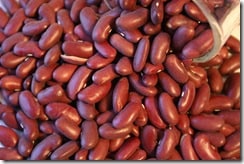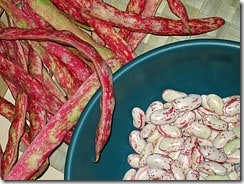Beans and legumes are among the healthiest foods you can eat. A vegetable protein, they contain fewer pesticides than animal products. They’re low in fat, and are versatile enough to absorb flavor from a wide variety of flavors and spices. With so many warnings about chemicals in canned foods, now might be the time to make the switch to home-cooked beans.
Dried beans are usually very cheap, although they take a while to cook from scratch so consider energy usage when making price comparisons. Make a large quantity and freeze to make the effort worthwhile. I’ll give a few methods.
The following instructions for cooking beans from scratch apply to kidney beans, chickpeas, dried peas, black-eyed peas, white (navy) beans, black beans, pinto beans, lima beans, fava beans, and lentils.
Cleaning:
Dried beans often contain dirt, insects, and small stones. Sort through the dry beans with your hands or spread them out in one layer on a plate. Remove stones, then cover with water. Insects will float to the top. To check larger beans for bugs, grab a handful of soaked beans and lay them out in one layer on your palm, check, and flip to the other hand to check the underside. You may see black spots through the skin. Remove the peel to see if they are insects.
Soaking:
Dried beans cook faster when they have been soaked for eight hours. Split peas, lentils, and black-eyed peas do not need to be soaked.
Chickpeas, black beans, lima beans and fava beans may also not need soaking. Kidney beans, white beans and pinto beans should be soaked. To soak, place in a large bowl and place enough water to cover the beans by about two inches. Beans expand a lot during soaking. You can soak them for several days in the refrigerator, but change the water every day or two.
If you forgot to pre-soak the beans, here’s a quick substitute method: Place the beans in a pot and cover with water, an inch (2-3 centimeters) higher than the level of the beans. Boil for one minute, remove from heat, and cover. After an hour you can cook the beans in your recipe.
You can also “soak” 1-1/2 cup of beans in a large bowl in the microwave along with four cups of water. Cover and microwave on HIGH for 12 minutes, or until boiling. Set aside for half an hour, drain.
Cooking:
Warning: Kidney beans, butter beans, and cannellini beans must be boiled at a high temperature for ten minutes to remove a toxin that can cause illness.
Conventional Method: Drain the soaked beans and cover with 3-4 times the amount of fresh water. Shorter times are for lentils, longer are for chickpeas or kidney beans. Save the cooking water, which is wonderful for soups and sauces. One cup of dried legumes expands to 2-1/2 cups during soaking.
Experts recommend adding half a teaspoon of baking soda to make chickpeas very soft for chumus, chickpea spread. It does remove some of the nutrients, and mashing the chickpeas removes even more.
Note: Cooking times also depend on the age and qualty of the beans, and vary widely. Blow on the bean. If it’s done, the skin will come off. Or taste one to see if it’s tender.
Slow cooker: 2-4 hours on low.
Conventional pot: 60-75 minutes for beans, 30-45 minutes for peas and lentils.
Pressure cooker: 10-20 minutes.
Microwave Cooking Method and Times: The microwave leaves beans plump and colorful, with unbroken skin.
Below are the amount of beans and water to place in a covered microwave-safe bowl with high sides, to avoid boiling over. After each legume I list the amount of cooking time and standing time. Smaller legumes are harder and may take longer to cook. Cook longer if you are going to puree, less time if you will be cooking further in another dish.
- Chick peas (60+10 min.), Black-eyed peas (25 + 5 min.), white beans (30-40 min.+ 5), red kidney beans (35 + 10), black-eyed peas (25 + 5 min.), pinto beans (60 min. + 10), and lima beans (large, 25 + 5 min., small: 45 + 5 min.): 1-1/2 cups of beans/peas and 6 cups of water.
- Fava beans: 2-1/2 cups of beans and 8 cups of water. Cook for 60 minutes and let stand for 10 minutes.
- Lentils: 1-1/2 cups beans and 5 cups water. Cook for 25 minutes, no standing tme.
- Split peas, yellow or green: 2 cups peas and 6 cups water. Cook for 25 minutes, no standing time.
Beans are done when they are soft, or the skin starts to break. If you are going to cook them further in another recipe, stop cooking when they are still somewhat firm in the center.
Tip: If you want the beans very soft, like for chumus (chick-pea spread), add a half a teaspoon of baking soda to the pot for a kilogram (two pounds) of beans. But avoid this technique, which reduces the nutrients in the food.
Cooked beans can be stored in the refrigerator or freezer. To freeze, lay out in one layer on a cookie tray. Transfer to a bag or container when frozen for easy access. Or freeze in one layer in a zippered plastic bag. For best results, divide into several packages and use quickly once opened. Refrigerated beans can last up to a week if stored carefully.
Sign up to get future posts straight to your inbox.
Need Ideas for Those Beans? Check out these posts.
Save Money by Eating Less Meat and More Vegetable Protein
Cooked Foods for Making Quick Meals
Lentils with Onions and Garlic
Microwaved White Beans Boston-Baked Style
Pinto beans photo credit: http://www.flickr.com/photos/oquendo/



What a great article! I’m going to have to mark this to read in depth later. One question – what about azuki / adzuki beans? I bought some in the shuk about a month ago because they looked interested and I wanted to try something new. I haven’t been able to find a real recipe – any ideas? I could just experiment, but I’d rather not end up with something that isn’t edible, and I’ve read that they are sweet so I’m not sure how to approach that.
Some of these look quite good, Debbie:
http://www.recipezaar.com/recipes.php?ls=h&foodid=7978
Color me stumped but how does baking soda/powder or mashing remove nutrients?
If you put X in the pot, and you mash it, it’s still X. If you add Y, you shouldn’t end up with less than the original X.
That’s true for the most part about minerals, but vitamins aren’t stable. A lot of vitamin C,, for example, is lost when you make orange juice. More if you shake it or let it sit for a long time. Anytime you chop vegetables you sacrifice some of the nutrition.
Some of those recipes look great! Thanks for sharing.
Vitamin C seems to be the most unstable – check this chart:
http://www.beyondveg.com/tu-j-l/raw-cooked/raw-cooked-2e.shtml.
I don’t mind about water soluble vitamins, since I’m usually consuming the liquid it’s cooked in. I figure with vitamin C you eat a couple of fruit and call it a day 🙂
Debbie, thank you for posting the link with that useful information.
Very thorough post. I’ll have to remember that you have written it when I need the information.
Thanks for the website, Debbie. It seems like a lot of vitamins are susceptible to degrading in alkali solution. And baking soda mixed with water creates an alkali solution…boy that is a handy chart!
Thank you for that post- I always do something wrong with my beans and they’re either falling apart mushy or still hard. I’ll follow your instructions next time and hopefully I’ll have better luck!
Hi,
I made chickpeas the way you said, soaked overnight boiled about 60 minutes. They were great. I made them on Friday and by Tuesday (stored in the fridge in a tupperware) they were slimy and had gone bad. Is that typical, should I freeze them rather?
Yael, in this heat things go bad much more quickly. Four days is not unusual at this time of year, especially they were left out at “room”(!) temperature for any length of time. All of the things I talk about here apply even more during the summer: Is This Food Safe to Eat and Nine Tips to Help Food Last Longer
I cooked dry lima beans today. I soaked them over night. I was using a recipe I found on line for soup. It called for a slow cooker and they were to cook for 8 hours. I have them on top of the stove boiling away and they have been cooking for 10 hours and are still incredibly hard. I have cooked lots of dry beans in the past 40 years and have never seen anything like this. Any ideas?
Hi Jane! I wonder where those bones have been. Beans do take longer to cook when they’re really old. Not sure it’s worth the energy to keep cooking them.
You say home-cooked beans taste better than canned beans. In my experience that’s not so. Your tips for cooking beans are good except that you say nothing about how to FLAVOR the beans to mimic the delicious taste of GOOD canned beans such as Van Camp’s or Bush’s canned beans. What spices and flavorings like catsup would you add to the beans?
Bob, that is a great question. Usually I cook beans plain for adding to other recipes, especially long-cooking ones as it’s not worth it to cook them for one meal at a time. But I plan to answer your question at length in an upcoming post.
can you refrigerate/freeze soaked beans? is it better to freeze soaked beans or cooked beans?
Hi Lalitha, Yes, you can refrigerate or freeze soaked beans. When refrigerated raw, soaked beans won’t keep for more than a couple of days, in my experience. Whether it’s better to cook them first depends on how you plan to use them in your recipes.